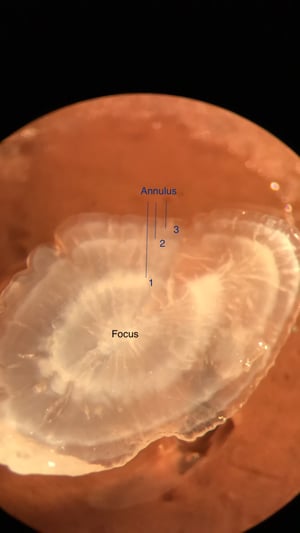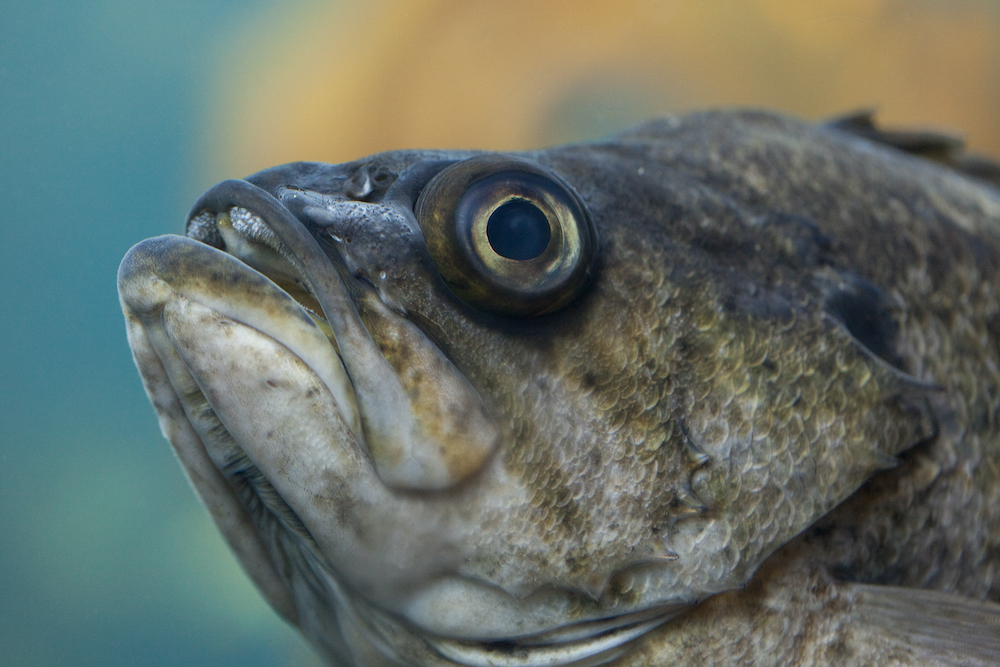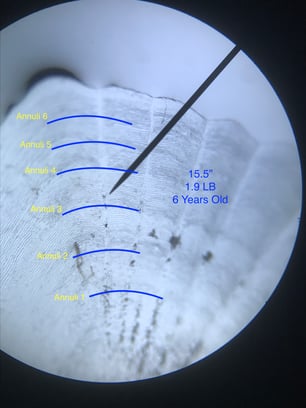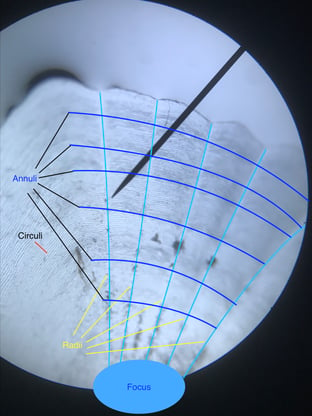To ensure your fish are achieving their optimal annual growth potential, when we conduct a survey, we gather a complete set of data, including the age of the fish. Whenever possible, we use fish scales to determine age because doing so doesn't harm the fish.
Data Used to Determine the Age of Fish
While conducting our electrofishing surveys, we collect many different metrics of data. We use length and weight data of the targeted species of fish to calculate the relative weights of the fish we record. In addition to environmental measurements, you may also see us collecting a few scales from each fish. We use these scales to estimate the age of the fish, which gives us a better understanding of what is going on in your lake or pond’s ecosystem,
Why age fish?
| Figure 1: Scale from a fish captured during electrofishing. |
|
|
We age fish to understand the condition of the fish in your lake or pond. We often compare the estimated age and current size of the fish against the expected size for a fish of the same age-based upon species-specific growth rates. We draw these comparisons in addition to calculating the relative weights of each fish because it is possible for a fish to be within the desired relative weight percentage but be much older than it should be. One example of this would be a fish I surveyed last year that was 15.5” and weighed 1.9 pounds (Figure 1).
The bass referenced had a relative weight of 93%, which is very good, but the fish was five years old. In a pond setting, bass can put on around 1 pound per year of weight. A five-year-old bass should realistically be around 5-6 pounds. Knowing the age allowed me to realize and address an issue that I would not have been able to see by just analyzing relative weights. In many instances, relative weights can be inflated by recent meals or spawning season (females), making the fish seem more closely related to the national average for its size class. Having the secondary metric of age to reference draws a more detailed “picture” of the population condition and allows us to create a better management plan.
Using Scales to Age Fish
| Figure 2: Fish Scale Diagram, Radii are the ridges extending from the focus to the edge of the scale. Circuli is each band/ring, and Annuli are formed by many circuli packed close together by a period of slow growth. |
|
|
We often choose to use scales to determine the age of a fish over more definitively accurate methods simply because taking a few scales from a fish does not harm the fish, and they will regenerate the missing scales. Reading a fish scale is similar to counting tree rings. But instead of counting each ring, like on a tree, we count “Annuli.” Annuli are formed by a tight grouping of “circuli” (individual rings) and indicate a period of slow growth. Typically, this slow growth is associated with winter. The circuli widen back during periods of rapid growth, usually associated with the warmer season (Figure 2).
The annuli present on the scale allow us to count the number of winters (slow growth) the fish has been alive. Since Texas has very mild winters, it can be challenging to see these annuli as fish often still exhibit some growth through the winter. With a lot of practice, this method of aging can be very accurate but is not always definitive. More accurate methods such as taking otoliths (inner ear bones) require the harvest of the fish for surgical removal. We determine the appropriate method of aging the fish on a case-by-case basis to ensure unnecessary removal of fish does not occur.
Other methods of aging fish
| Figure 3: Otolith from a Redear Sunfish (Lepomis microlophus). |

|
Other hard structures of the fish can be used for aging as well. Structures, such as Otoliths that I mentioned earlier, and hard spines (often used for catfish) are two other common options. These methods are more invasive and require the harvest of the fish. When dealing with small-scale ponds, we opt out of any unnecessary harvest to minimize the impact on the population size. Otoliths can either be viewed whole or cracked under a dissecting scope by applying a thin layer of clarifying liquid such as glycerin or clove oil. Spines can be cross-sectioned with a jeweler saw into a very thin layer, which, like the otolith, can be viewed under a dissecting scope with a clarifying liquid. The otolith and cross-section of the spine will have a focus/nucleus in the center and annulus (bands) surrounding it. You can accurately determine the age of the fish by counting the number of annulus bands.
Electrofishing surveys, reports, and pond management
We strive to produce the best survey reports and management plans we can. In doing so, we take full advantage of any metric that we can analyze to increase our understanding of what is going on beneath the water’s surface. If you have any more questions about electrofishing surveys or aging fish feel free to contact me at ethan@pondking.com. You can also download our DIY Pond Management App for more information or watch our video about aging fish on YouTube.
See y’all down at the pond.






